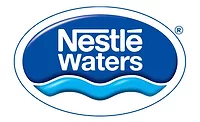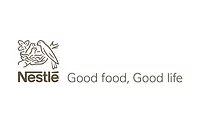Nestlé Waters
![]()
Nestlé Waters
North America: Focused on perfor mance
In a beverage industry where an
ever-increasing number of new products compete with flashy marketing campaigns,
Nestlé Waters North America has instead focused on a single product,
and prefers to be noticed for its emphasis on people and high-performance
manufacturing. The company recently invited Beverage
Industry into two of its bottled water facilities — its
Poland Spring plant in Hollis, Maine, and its recently built Arrowhead
plant in Cabazon, Calif. — to demonstrate its efforts to combine
high-speed, low-cost production, environmental concerns and a strong corporate
culture.
As beverage companies
go, Nestlé Waters has a fairly new network of production facilities,
most of which were built during the past 15 years. For a company that
now holds about 35 percent of the bottled water market — with sales
growth this year of 10 to 15 percent — that has meant adding plants
at a fast clip. It estimates that continued growth in the bottled water
industry will require construction of one
new plant a year for the next 10 years. Building so many new facilities
has allowed the company to develop practices that can be standardized
across its plants nationwide, and today’s new
plants are built on similar models of efficient production.
Chief Executive Officer
Kim Jeffery says Nestlé Waters’ model of low-cost production
took form during the early 1990s when the company realized the growth
potential of bottled water would soon bring
a big wave of competition. “I knew 12 or 13 years ago that if we
were going to insulate ourselves [from the competition], we needed to
be vertically integrated and a low-cost manufacturer,” he says.
“It didn’t happen overnight, we had to learn how to do it
and get good at it. The standardization today is the accumulation of 10
or 12 years of learning.”
As a vertically integrated
company, Nestlé Waters is responsible for producing its own packaging, making its own package preforms and
blowmolding its own bottles. Another example of cost-saving efficiency
is the company’s choice to use a warehouse delivery system as opposed
to direct store delivery.
“We don’t
go to market DSD, we use people’s warehouses, and we think it’s
an advantage in this day and age,” Jeffery says. “The bigger
customers get, the more they like doing business the way we do it, and
if we can be the best guy to do business with, we’re really in an
advantage situation.”
He says the company recently
reorganized a bit to allow even better access to customers with a more
regional approach to distribution.
“We’ve spent
a number of years getting to best-in-class in logistics and manufacturing,”
he says. “Now that we’ve done that, we’ve married up
those responsibilities regionally. By decentralizing, we’ve been
able to put a regional focus on best practices from a logistics standpoint.”
Decentralizing distribution
responsibilities is an example of the way Nestlé Waters has attempted
to both standardize operations for maximum efficiency and put decision-making
in the hands of its employees. Nestlé Waters plants, for instance,
have incorporated self-guided teams that run their own daily debriefing
meetings to discuss what went well during the day and what could be improved.
“The debrief process
came about because we want people managing themselves and the assets that
they are in charge of,” Jeffery says. “The supervisors are
there to support their activities, but these are self-directed work teams.”
He says the philosophy
begins with hiring the right people and maintaining a corporate culture
based on the notion that “if you like what you’re doing and
you like who you’re doing it for, you’re going to do great
things.”
“Results are really
important, but the way you get results is even more important,”
he continues. “We’ve got really high-caliber people who have
been here for a long time. We have low turnover, and we have people who
like coming to work every day and want to do great things.”
The company has discovered that implementing benchmarking measurements
not only helps improve operations, but feeds the desire to do great things at
work.
“We don’t do Six Sigma here, but we do our own brand of making ourselves better,” Jeffery says.
“We don’t do Six Sigma here, but we do our own brand of making ourselves better,” Jeffery says.
Continuous improvement
measurements are taken for each of its brands and facilities, and the
company also consolidates and implements best practices on a national
basis.
“If you have introspective
people, they’ll look at themselves and see the opportunity to improve,
and then they just go after it,” Jeffery says.
An eye on the
environment
Bottled water, more than other
beverages, seems to raise the ire of environmentalists. Nestlé
Waters has taken great pains to not only communicate its view that it
is a natural resource company, but to incorporate a wide variety of environmental
protection measures. Its Cabazon, Calif., facility and its Ice Mountain
facility in Stanwood, Mich., both have received certification from the
Leadership in Energy & Environmental Design (LEED) program of the
U.S. Green Building Council, and three other new facilities will seek
certification this year.
“We do great environmental
work before we come into a place, and continuous monitoring work to make
sure the water resources are sustainable for a long time,” Jeffery
says. “You can’t build a plant on wheels. The spring water
source has to be there 100 years from now, and in order to do that, we’ve
got to have good land use practices and aquifer practices. We’ve
got to know what’s coming out of there and how fast it’s being
replenished. The health of the aquifer is paramount to us.”
Because the company has
encountered protest in some of the areas it has chosen for
new projects, it has developed a number of efforts to communicate its
environmental stand.
“When we go into
an environment like [Hollis], which is basically a pristine environment,
and buy the springs and use the water, it’s a more obvious use of
water than someone turning on a faucet or using a municipal water supply,”
Jeffery says.
“We want to be transparent
with our communities. We want to help create context around what we do
so people don’t fear it, they understand it. At the state levels
where we operate, we are taking a much more proactive position regarding
educating legislators and regulators about what we do.”
Part of a global business
In North America, Nestlé
Waters produces a number of mostly regional bottled water brands such
as Poland Spring, Arrowhead, Ice Mountain, Deer Park, Zephyrhills, Ozarka
and Calistoga. Nestlé Pure Life, one of the company’s international
brands, also is quietly achieving big sales in the United
States. So far, its sales have remained under the radar because much of
it is sold through Wal-Mart, which is not measured by the national syndicated
data services.
“Pure Life is going
to be big,” Jeffery says. “It’s big right now, and it’s
going to be bigger. We have lots more distribution of Nestlé Pure
Life that we need to get, but we’re taking our time and doing it
in a consistent manner.”
While the company also
has some flavored sparkling waters on the market, it has yet to enter
the enhanced water category in North America. But don’t rule it
out for the future. Jeffery says, “I believe that for this category
to achieve its long-term potential, there are going to have to be some
things that happen in flavor technology and
packaging technology. You can see examples of the way we’re working
on that [outside the United States].”
Nestlé Waters North
America draws on the resources of its Switzerland-based parent
company, including a new global water R&D facility in France, for
product development.
“Something people
don’t see in us is the global nature of our water business,”
Jeffery says. “It’s not just about what we do in the United
States, but we have a lot of reach and capability [globally]. In our group
at Nestlé, that’s all we do and that’s all we’re
focused on, which I think is a competitive advantage.”
Jeffery says the company
feels good about the progress it has made, especially during the past
five years as it has reaped the benefits of its push for performance.
But he says, “We feel we’ve got lots more improvement to make;
we’re never satisfied with where we are.”
“I don’t like
to make big projections about where the company’s going to be —
I think you need to stay humble about your business,” he says. “But
I’m very optimistic about our future.
I feel really good about it and our brands.” BI
Looking for a reprint of this article?
From high-res PDFs to custom plaques, order your copy today!




